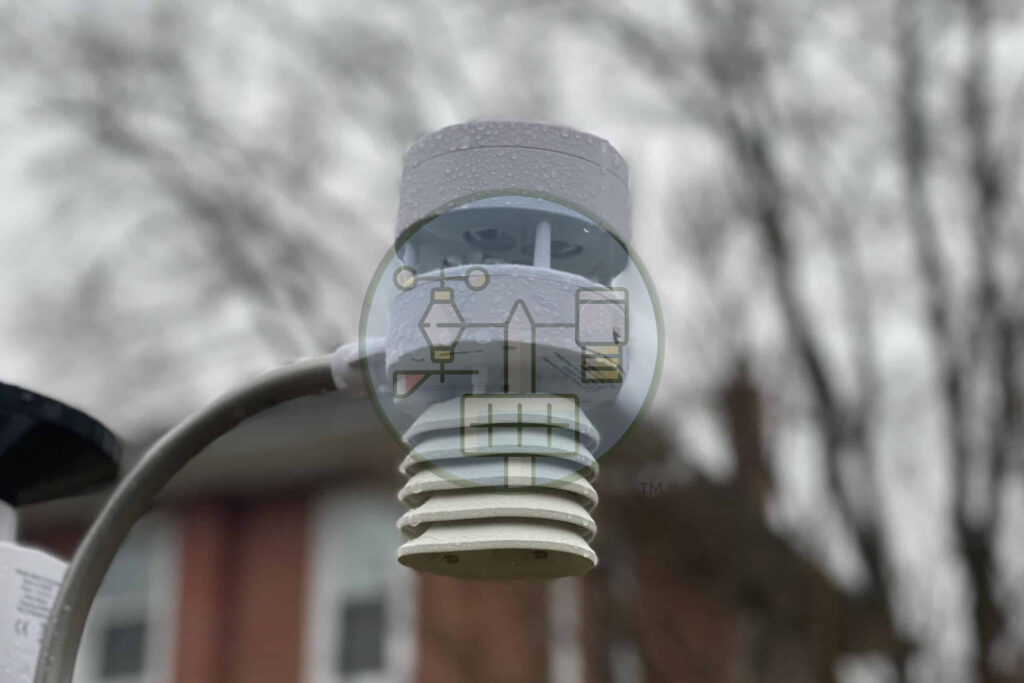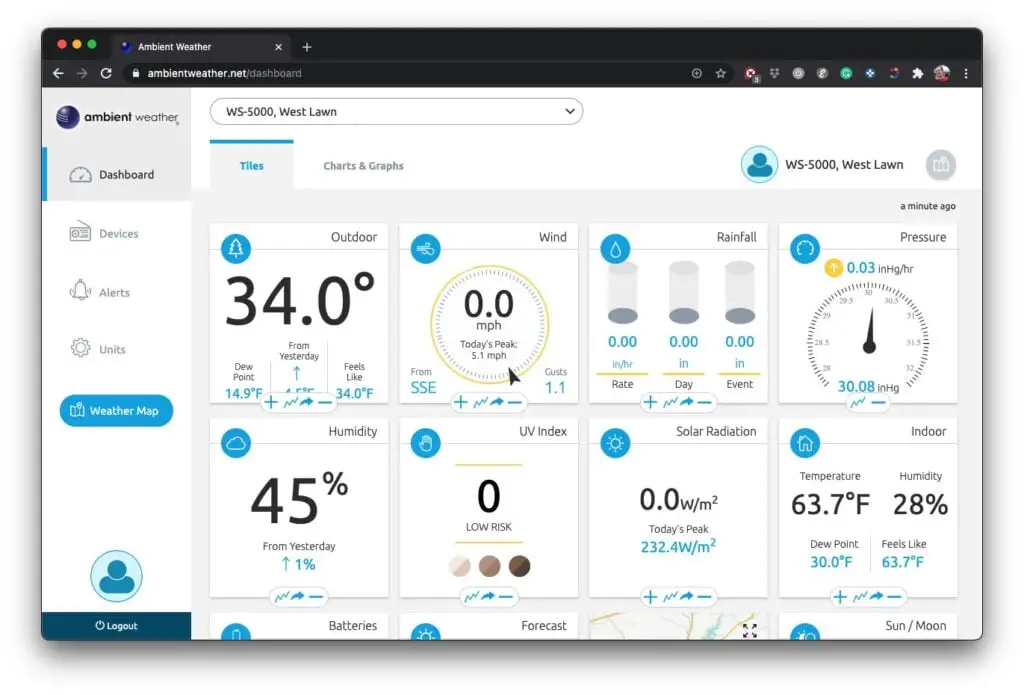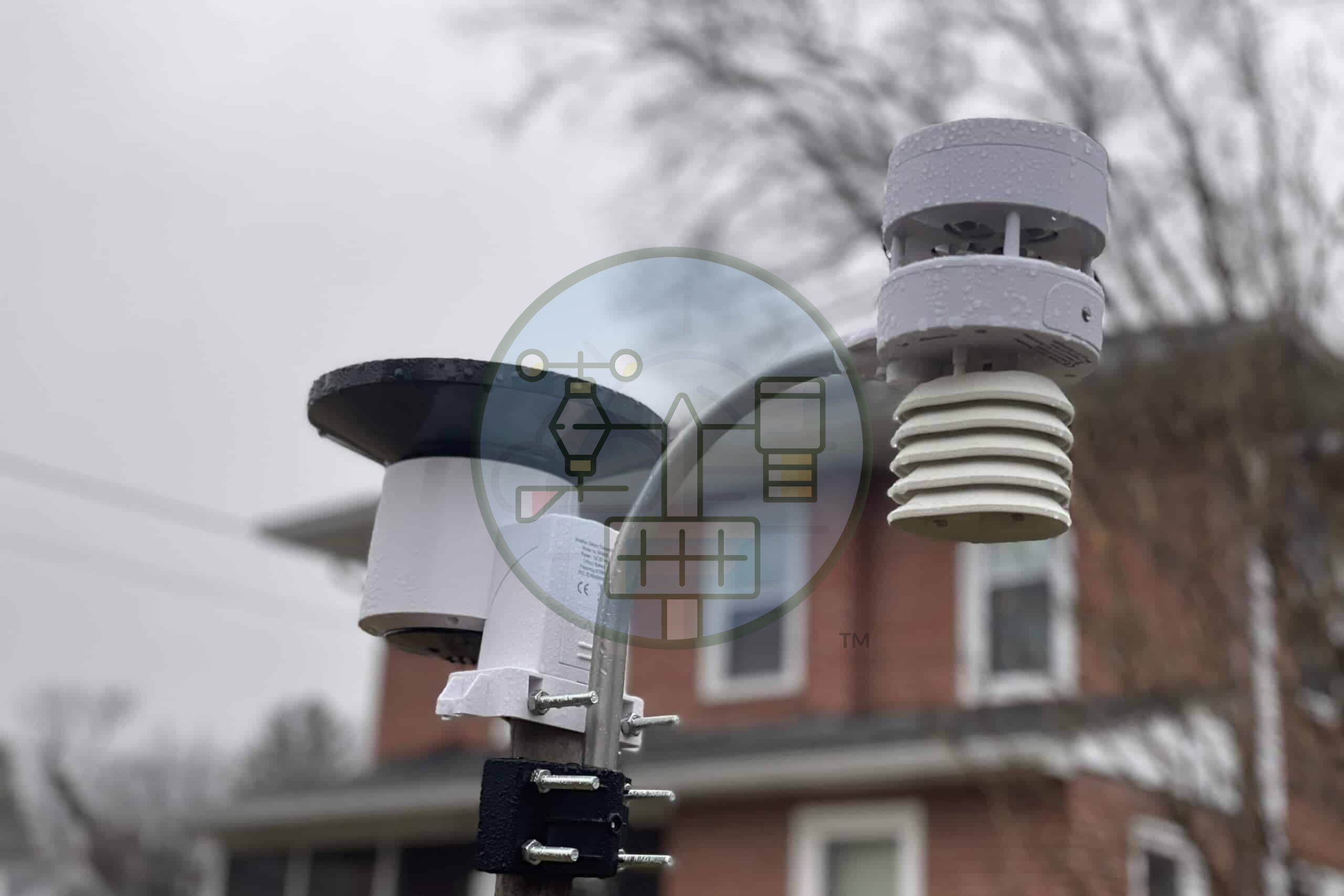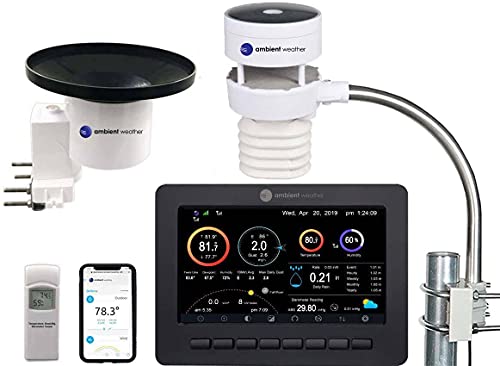The WS-5000 features a redesigned sensor suite, including an ultrasonic anemometer. Eliminating the cup anemometer found on other weather stations drastically reduces the number of moving parts and can measure wind speed as accurately as the cup-and-vane. This should extend its useable life as the traditional anemometer requires ongoing maintenance to ensure trouble-free use.
The Ambient Weather WS-5000s sensors were much more accurate in our tests than the WS-2902 and WS-1965, which use slightly lower-quality sensor suites. Thanks to expandability and a wide array of optional additional sensors, you can add just about any sensor you can think of, including air quality, soil moisture, water temperature, and lightning, all of which send data to the console in as little as every five seconds.
The company has made it easy to share your data publicly through Weather Underground. Its smart home connectivity is best in class, offering IFTTT compatibility to connect your station to your smart home system. Of course, there’s the Ambient Weather Network and the Ambient Weather app to view your personal weather stations’ data remotely on your mobile device or through the web app.
Ambient Weather’s weather stations have become what I expect to see in mid-range models. The company all but defined the budget end of the spectrum with the WS-2902 series, which performed almost as well as the Davis Vantage Vue and offered best-in-class smart home connectivity. I couldn’t wait to test the Ambient Weather WS-5000 out for myself.
The station is the first to be produced under Ambient Weather’s new ownership, Nielsen-Kellerman (although it is essentially the same station as the Ecowitt WS80 available outside of the US). You may not know that name, but you’ll likely recognize their Kestrel brand. They’re also known for their pro-grade Rainwise weather stations. I’d expect the WS-5000 to show some of the benefits of that team-up.
Indeed, the WS-5000 is unlike any Ambient Weather station we’ve seen before. It looks and feels like a higher-end weather station. The vane and cup anemometer now uses ultrasonic technology, and the housing also includes UV and light sensors on the top and shielded temperature and humidity sensors below.
The rain gauge is a separate unit with a larger funnel that improves rainfall measurements. The WS-5000 removed the temperature, humidity, and barometric instrumentation from the console and placed it in a separate sensor.
The same full-color LCD console in the WS-2000 is also in the WS-5000 package, with a few new benefits, including faster update time.
WS-5000 Setup

Ambient Weather sent along what appears to be their entire suite of additional sensors. We received:
- Indoor PM2.5 Air Quality Sensor
- Outdoor PM2.5 Air Quality Sensor
- Lightning Detector
- Soil Moisture Sensor
- Waterproof Temperature Probe
- Leak Detector
As of this review, it’s winter, so testing every sensor is impossible. But I did try a few of them to get an idea of how the process worked.
The station arrives mostly assembled: there is not much to put together other than mounting it with your mast or mounting solution. Be sure to have some “AA” batteries on hand in case they’re not in the package. You’ll need about 30 minutes to get things running.
Our setup wasn’t trouble-free, however. The rain gauge and indoor temperature/humidity/barometer sensor wouldn’t connect automatically, which slowed us down. The optional sensors I tested didn’t have the same problem, so I’m unsure of the cause. Ambient Weather has a support document addressing the issue that allowed the sensors to connect.
Next up was connecting the WS-5000 to your Wi-Fi and the Internet. Doing so enables remote access to your data through either AmbientWeather.net or third-party services like Weather Underground. It lets you connect to various smart home services, including Amazon Alexa, Google Assistant, and IFTTT.
That took minutes: all we had to enter was our console’s MAC address (on the back), and within two or three minutes, the station was live and reporting to the cloud.
If I had to choose something I didn’t like, it was the on-console portion of the setup process. The WS-5000 doesn’t have a “setup wizard” like many stations. Instead, you’re forced to navigate through the console menus, which is cumbersome.
A solid upgrade

Even though we didn’t have the smoothest setup, I enjoyed the rest of my time with the WS-5000. The TFT LCD console, first debuted in the WS-2000, is also the WS-5000’s. Using an actual display instead of the LCD panel found in the WS-2902 allows the console to display various types of data, including graphs and charts.
The display is viewable at any angle, and you use the buttons across the bottom to navigate through the data onscreen. All your key observations are large enough to be readable several feet away. However, Ambient Weather has spots on the screen for just about all of its sensors, and it is a lot of data.
As you add more sensors, more screen real estate is filled. With all the sensors online, I found it a little crowded and overwhelming. However, some weather enthusiasts will appreciate having so much data. It’s just not for me.
(We recommend the WS-5000-IP3 for this exact reason, and it’s nearly $100 cheaper, too).
The issues we experienced with the barometer and rain gauge with the WS-2902 aren’t found in the WS-5000. The WS-5000’s barometer responded more accurately to pressure changes, whereas the WS-2902 seemed to respond too aggressively (although that could be due to a defective unit; we’re still unsure).
The larger rain gauge funnel seemed to do what it intended: catch rainfall more accurately. While we certainly didn’t have much data from our review due to a lot of frozen precipitation, the WS-5000 was close to our analog rain gauge readings.
The new sensor suite features a lightning-fast console refresh time (how often the console displays new data) as little as five seconds in some cases. That’s a massive improvement from the WS-2902 console, which could take up to a minute to update.
The sonic anemometer impressed us as well. We found the readings to be much more accurate and responsive, even though it only has a maximum speed of 89mph. We recommend the optional heater accessory for colder climates to keep the sensor surface from accumulating ice and snow. The only issue is that it requires an AC outlet to power itself, which might not always be available.
Connectivity and Smart Home

The WS-5000 uses the same connectivity platform as any other Ambient Weather Station. AmbientWeather.net, the company’s cloud service, allows access to your station via the web or an app. The web app (above) and the mobile app use the same interface, so it’s not too tricky.
You can also connect your WS-5000 to smart home devices through the AmbientWeather.net portal. IFTTT, Amazon Alexa, and Google Assistant are supported. With IFTTT, connecting smart devices is super easy—like your sprinklers or lights—using data from your WS-5000 to turn them on and off. We think that’s pretty cool.
For some, this might not be a big deal. But with smart home technologies becoming so ubiquitous, we think it is a vital feature to have these days (at least in our opinion). The WS-5000 sports an impressive combination of accuracy and best-in-class smart home connectivity, a feature for which Davis weather stations are woefully behind.
With voice assistants, asking Alexa or Google Assistant to run the Ambient Weather skill gives you a full weather report. However, we’d like to see improvement in the ability to request a specific variable. Currently, asking for the weather report gives you all the measurements from the device.
With many additional sensors, Alexa or Google Assistant will be slow to respond.
Ambient Weather offers a weather station positioned between the WS-2902 and the WS-5000, called the WS-2000. It’s a mix of the two, featuring the WS-2902’s sensor suite and the TFT LCD console from the WS-5000. While cheaper than the WS-5000, the WS-2902 sensor suite has limitations.
Instead of updating as fast as every five seconds, data is delivered every 16 seconds from outdoor and 64 seconds from indoor sensors. You also have to deal with the sensor issues that the WS-2902 has, including rainfall over-measurement issues and a wonky barometer.
I recommend you opt for the WS-5000 instead, as the price difference isn’t that significant. The improvement in accuracy makes it worth it, and it’s still cheaper than a Davis. Plus, it’s a more modern sensor suite that will likely hold up better over the longer term.
Quirks aside, the WS-5000 rocks
While the WS-5000 has a few quirks, they aren’t show-stoppers. This is the best weather station Ambient Weather has, hands down. If you can’t afford the Vantage Vue, you’ll get close to the same performance out of this weather station.
The issue with Davis’s line of stations is the lack of genuine connectivity, particularly concerning smart home support. Ambient Weather has made a name for itself in this area.
If you’re a heavy smart home user, the WS-5000’s feature set might better serve you than competing stations. Davis only supports Amazon Alexa, not Google Assistant or IFTTT. If smart home connectivity is less important, you might still want to consider the Vantage Vue for its proven long-term reliability.
But on sale, the WS-5000 is tough to refuse. We plan to have this station installed for a long time and report on its reliability.





Thanks for the comprehensive review. I’m a happy owner of a wired Davis Vantage Pro 2 but as a weather geek, I’m always curious what the market is doing. I’ve always been fascinated with the sonic sensors and have always coveted the Vaisala Weather Transmitter WXT520 (now the 530) but it’s nearly $2,000 with all the same sensors that my DVP2 has at half the price.
You didn’t say, but you note that the rain and other sensors are separate devices. Additional cost items, I suppose? I’ll have to go look at the pricing sheets to see.
Thanks again.
Hey Guys New to the site. Thinking of purchasing the WS5000. Any idea when next sale may be on the unit. Do they typically do Memorial Day Deals? On another note with Tariffs easing possible price drop?
Prime Day most likely!